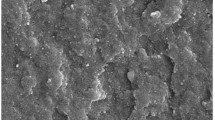Abstract
The dynamic rheological behaviors are measured by small amplitude oscillatory shear on a rotational rheometer for a low-density polyethylene (LDPE)/polystyrene (PS)/styrene–butadiene–styrene (SBS) block copolymer blend with the tool of cole–cole plot. The morphology of the blend is measured by scanning electron microscope (SEM) micrograph, the storage moduli–angular frequency (G′–ω) data are fit by the Palierne model, and the relaxation time spectrum is investigated. The storage modulus and loss modulus of the LDPE/PS/SBS blend at low frequency increase when the weight ratio LDPE/PS increases from 10/90, reaches a maximum of 30/70, and drops thereafter. The cole–cole plots of some blends (10/90/3, 70/30/3, 90/10/3 and 100/0/3) have only one main arc due to compatibilizing effect of the SBS, and those of other blends (0/100/3, 30/70/3 and 50/50/3) have a second arc or a long tail besides the main arc probably due to phase separation. The SEM micrographs of the LDPE/PS/SBS = 10/90/3, 30/70/3, 50/50/3 show sea-island, semi-co-continuous and co-continuous structure, respectively. G′–ω curve of two LDPE/PS/SBS = 30/70/3 and 50/50/3 blends shows a power law, and the power index is much lower than one (0.748 and 0.817), respectively, showing a co-continuous morphology also verified by the SEM micrographs. The experimental data of G′–ω curve of the LDPE/PS/SBS blends are fit by Palierne model, the deviation between the fit line and the experimental data increases gradually as the LDPE/PS weight ratio decreases from 90/10 to 10/90. For the LDPE/PS/SBS blends, the weighted relaxation spectra τH (τ)–τ show a main as well as a second arc or tail; the former corresponding to the relaxation of PS phase and the latter corresponding to that of LDPE phase. Due to the compatibilizing effect of SBS the relaxation time and spectrum strength of LDPE/PS = 50/50 (wt) blends are both increased.







Similar content being viewed by others
References
Li RM, Yu W, Zhou CX (2006) Phase behavior and its viscoelastic response of poly(methyl methacrylate) and poly(styrene-co-maleic anhydride) blend systems. Polym Bull 56:455–466. doi:10.1007/s00289-005-0499-6
Shi DA, Ke Z, Yang JH et al (2002) Rheology and morphology of reactively compatibilized PP/PA6 blends. Macromolecules 35:8005–8012. doi:10.1021/ma020595d
Wu DF, Zhang YS, Zhang M et al (2008) Phase behavior and its viscoelastic response of polylactide/poly(ε-caprolactone) blend. Eur Polym J 44:2171–2183. doi:10.1016/j.eurpolymj.2008.04.023
Graebling D, Muller R, Palierne JF (1993) Linear viscoelastic behavior of some incompatible polymer blends in the melt. Interpretation of data with a model of emulsion of viscoelastic liquids. Macromolecules 26:320–329. doi:10.1021/ma00054a011
Choi SJ, Schowalter WR (1975) Rheological properties of nondilute suspensions of deformable particles. Phys Fluids 18:420–427. doi:10.1063/1.861167
Gramespacher H, Meissner J (1992) Interfacial tension between polymer melts measured by shear oscillations of their blends. J Rheol 36(6):1127–1141. doi:10.1122/1.550304
Sung YT, Han MS, Hyun JC et al (2003) Rheological properties and interfacial tension of polypropylene-poly(styrene-co-acrylonitrile) blend containing compatibilizer. Polymer 44:1681–1687. doi:10.1016/S0032-3861(02)00920-5
Macaúbas PHP, Demarquette NR (2001) Morphologies and interfacial tensions of immiscible polypropylene/polystyrene blends modified with triblock copolymers. Polymer 42:2543–2554. doi:10.1016/S0032-3861(00)00655-8
Ibnelwaleed AH, Tayyab H, Basel FAS et al (2003) Miscibility of hexene-LLDPE and LDPE blends: influence of branch content and composition distribution. Polymer 44:4665–4672. doi:10.1016/S0032-3861(03)00437-3
Utracki LA (1991) On the viscosity-concentration dependence of immiscible polymer blends. J Rheol 35:1615–1637. doi:10.1122/1.550248
Tschoegl NW (1989) The phenomenological theory of linear viscoelastic behavior. Springer, Berlin
Author information
Authors and Affiliations
Corresponding author
Rights and permissions
About this article
Cite this article
Liao, Hy., Lu, Hb. Rheological behavior of a LDPE/PS/SBS blending melt. Polym. Bull. 71, 3237–3247 (2014). https://doi.org/10.1007/s00289-014-1247-6
Received:
Revised:
Accepted:
Published:
Issue Date:
DOI: https://doi.org/10.1007/s00289-014-1247-6




